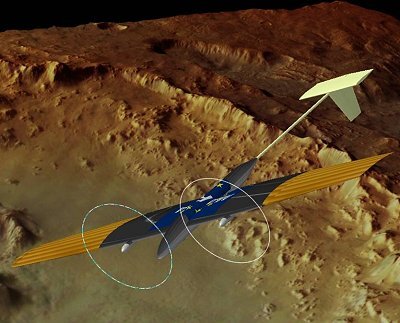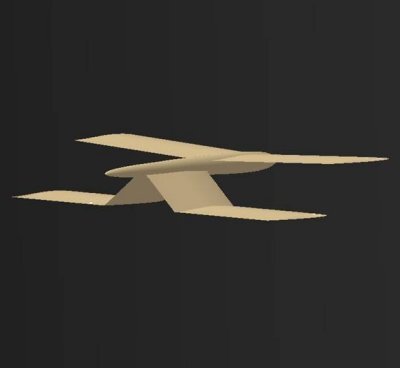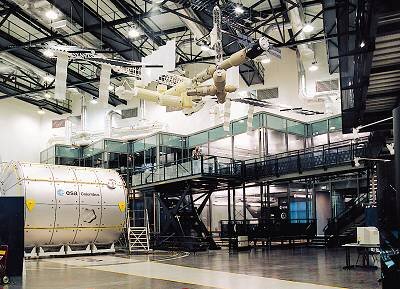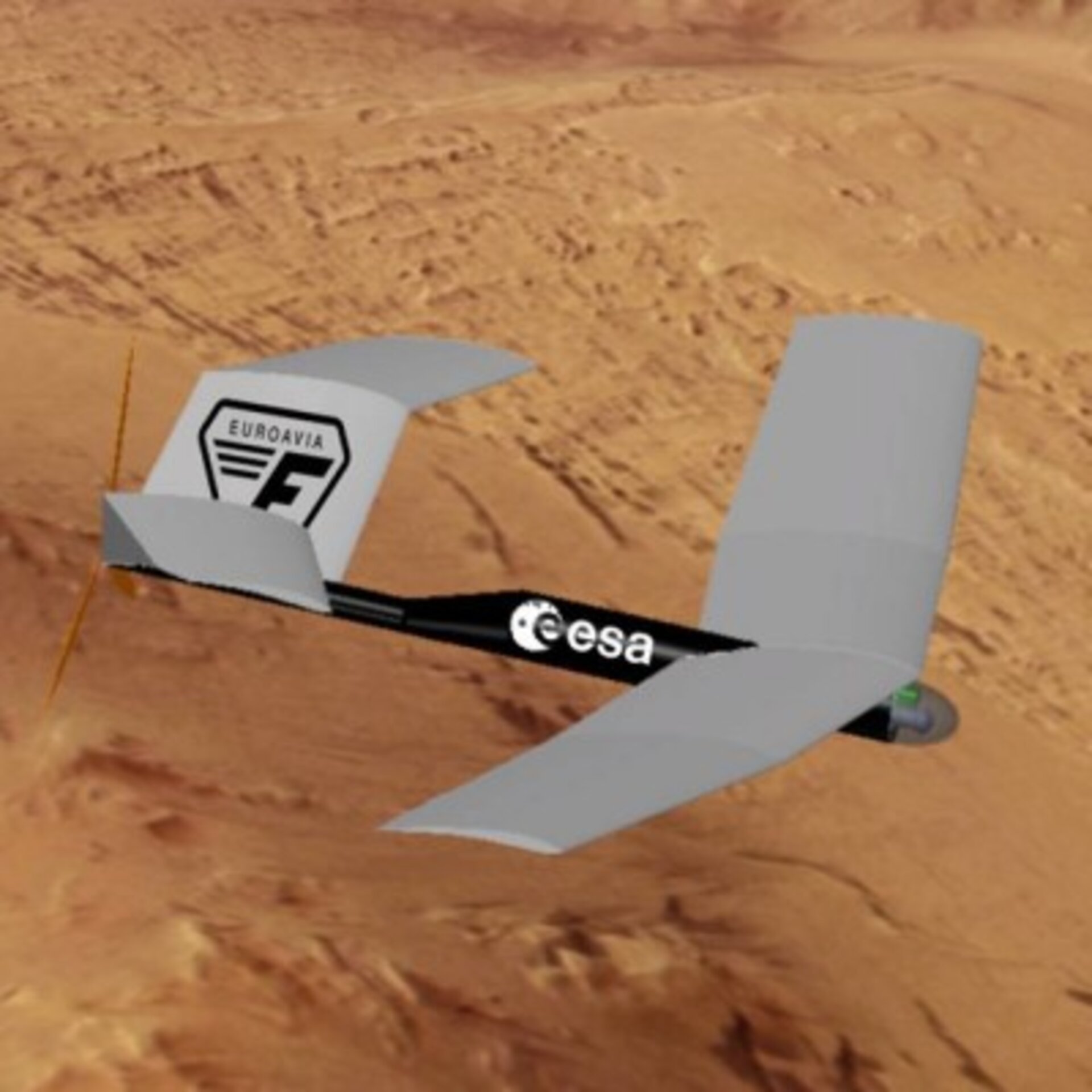Euroavia students design Martian aerial vehicle
Higher resolution than from an orbiter and a greater range than a rover – European aerospace engineering students recently presented their design concepts for an Unmanned Aerial Vehicle (UAV) for Mars in ESA’s Erasmus Centre.
As part of its outreach efforts and cooperation with academia, the European Space Exploration Programme Aurora supported the European Association of Aerospace Students (Euroavia) for its 2006 Design Workshop. The topic chosen was the preliminary design of a Unmanned Aerial Vehicle (UAV) for the exploration of Mars.
Although there were initially plenty of different thinking-outside-of-the-box design proposals on the table, the participants of the three week long design workshop opted for a more conventional aircraft design, which was found to be the most reliable and feasible. Balloons were ruled out because of lack of control over the flight path, gliders because of insufficient mission duration, rotorcrafts because of stability issues and air ships because of a not sufficient payload capacity. However, here the similarities come to an end; the resulting aircraft designs were notably different to each other.
Arriving at ESA’s Erasmus Centre on 17 July, the 30 students who came from various European countries and Canada, first had to define their mission and draw up mission requirements. These were worked out after attending presentations by ESA experts on the status of Mars exploration and on the scientific questions still open. It was a good exercise for the students to swap perspectives and think in terms of scientific usefulness and outcome. They were then divided in three teams and started to develop their concepts.
ARMaDA

Team 1 created the ARMaDA, the Advanced Reconnaissance Martian Deployable Aircraft. The mission would acquire high resolution images of the surface of Mars to find landing sites for future human and robotic missions and investigate the quality of the soil and determine its composition.
Team 1 planned not only to deploy one UAV in the Martian atmosphere, but managed to put three aircraft under the fairing of an Ariane-5 - the agreed launcher for all three teams. As power supply they choose a Sterling Radioisotope Generator – a system that so far has not been used for space missions.
“I think our own design was very future orientated”, said Nils Harmsen, from Team 1. “It was not for a UAV that will fly in the next 5 or 10 years or anywhere between. It was very challenging and we tried to build a UAV that will fly in maybe 20 or 25 years. So we were very ambitious in our power system and also with the other systems.”
MAREA
Team 2 preferred to create a UAV that could be flown within five years from now. MAREA, the Martian Aerial Research Euroavia Airplane, was designed as a fully-autonomous and programmable aircraft that uses its own orbiter to communicate with the mission controllers back on Earth.
As a special feature it has inflatable wing extensions, which allow for a wing span of almost nine meters despite the constraints in dimensions inflicted by the Ariane-5 launcher. The power supply system is a combined solar/fuel cell solution that enables MAREA to stay for up to 40 hours in the Martian atmosphere. The scientific payload can provide data on the topography, the atmosphere, the soil and the magnetic field of Mars.
KLIMars

Team 3 choose to investigate local weather conditions on Mars and to make use of the specific advantages a UAV has over a rover in terms of range and an orbiter in terms of accuracy.
During their KLIMars Mission they planned to drop 25 weather stations from the UAV along a spiral flight path. The UAV would eventually land in the centre of the spiral and serve as a communication hub for the deployed weather stations to the orbiting satellite. In this way data on the temperature, the pressure and dust could be acquired for up to five years when finally batteries and solar cells deteriorate and cease to work.
Their airplane design was to be a bi-plane to avoid wing folding and to increase lift. The power should come from the Sun. Solar cells would supply the electrical motor that moves the propeller as well as all the onboard systems.
Inspiring
The students attended a series of lectures on specific topics and two tutors were always available to help out with their knowledge. It certainly helped that the Erasmus Centre of the Directorate is located in the heart of the Directorate of Human Spaceflight, Microgravity and Exploration, where ESA experts and real spaceflight hardware can be found in every corner.
“Following the first lecture here it was quite impressive to see all these prototypes and all the models actually in front of us because we are not experienced in space, and have not had a chance to visit such buildings before,” said Athanassios Baltopoulos, from Team 3.

“It was exciting to have real things around us and all the people that could help us with real requirements that we needed and to just write an e-mail to someone to bring somebody to help us. It was the perfect environment to do such a thing.”
Daniel Dodd from Team 1 added, “Working the long hours can get really draining and enthusiasm starts to wane. But when you are sitting around items almost like in a space museum and items that have been in space it is really inspiring and it gives you a bit more motivation to actually get on. If we were sitting in a room with blank walls we would have never come up with the concepts and the products in the end of the day that we did.”
Rewarding
In order to create detailed and technically sound design concepts within three weeks time the students had to put in some nightshifts and they experienced something quite unique and challenging at the same time, namely to work in a multicultural team together with people they had never met before.
“Overcoming the language barriers was one of the most rewarding experiences”, said Daniel Dodd from Team 2. “It was difficult during the process. Things like orders of magnitude and certain numbers and figures we would miss unfortunately and then days later we would find out that it was a miscommunication, purely from a language barrier. So personally I have learned from this that everything has to be put down in numbers, in figures in written rather than just spoken language.”
Tamara Sopek, leader of the Euroavia DeWo Working Group, which organised the design workshop, adds: “I think they gained a very valuable experience in working in multinational teams. There are a lot of differences in culture so they had to learn to get along with each other.” Euroavia was very pleased not only with the outcome of the workshop but also with the organisation. “It went very well. We are very satisfied with the workshop and the students and their work motivation and their interest in it. They worked the whole day long and even during the night. They were very successful in their mission”, said Sopek.
Long-term strategy

The workshop was supported and hosted by ESA’s Directorate of Human Spaceflight, Microgravity and Exploration as part of its long-term strategy for space exploration, to encourage young engineers to become involved in the development of the necessary technology to explore our Solar System.
Piero Messina, from the Directorate’s Aurora programme explains: “The European exploration programme Aurora has the ambition to prepare Europe for the exploration of the Solar System, notably Mars and the Moon. This will occur in the next decades and therefore it is important that we work with the European universities and students for two reasons. Firstly, because we want to obtain from them innovative ideas and concepts that will enable space exploration, and secondly, because we want to prepare the future workforce that will implement the programme itself.”
“The reason why we have chosen this topic, namely an unmanned aerial vehicle for the exploration of Mars is based on several reasons,” adds Messina. “The main reasons are that this is a very innovative and new topic for the students to work on, and also, due to the constitution of the Euroavia association, it was an ideal situation to get the aeronautical engineers working together with space engineers on such a topic.”
The latter already worked out as far as some of the aeronautical students are concerned. They have expressed their desire to study more about space engineering in order to understand whether this is a possible future career opportunity for them.
Jury
The jury, consisting of experts from ESA and industry who evaluated the design concepts, was impressed by the amount of work done in such a short space of time and was of the opinion that the long hours the students spent on calculating figures, finding data and coming up with solutions paid back in great results.
The jury members liked all three design concepts and saw the concept of Team 3 as the most creative, but also the one that needed some more thought regarding certain aspects.
Team 1 had a very structured approach in the opinion of the Jury but the concept was also a very demanding in terms of power. Team 2’s design was more conventional and very robust.
As the spokesperson of the Jury, Eckhart Graf from ESA’s Directorate of Human Spaceflight, Microgravity and Exploration put it: “I would hire all of you at once, if I could.”
For further information please contact:
Piero Messina
Aurora Exploration Programme
Directorate of Human Spaceflight, Microgravity and Exploration
Mobile: +33 6 87715126
E-mail: Piero.Messina@esa.int
Dieter Isakeit
Erasmus Centre
Directorate of Human Spaceflight, Microgravity and Exploration
Tel: +31 71 565 5451
Fax: +31 71 565 8008
E-mail: dieter.isakeit@esa.int
Final presentations and interviews with participants and experts can be watched via streaming internet at: streamiss.spaceflight.esa.int




